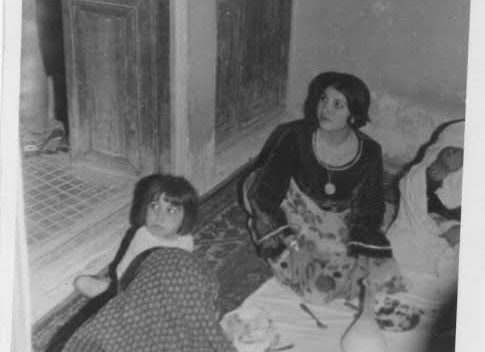Division – Part Three: Zohreh
Soheila Azadi tells stories of her experiences as a Muslim woman living under a theocracy in Iran with the spatial separations between the sexes and races.

This is part three of a five-part short story series. Read part two here.
Blue is the color of mom’s eyes; blue is the color of our pond where we all gather around in warm and dry summer evenings in our private courtyard. A pomegranate tree holds a rope full of clothes in our courtyard, clothes that mom washed all day. Men’s clothing rest carelessly on the rope yet women’s clothes rest carefully. Women’s undergarments are covered with scarves. Bra straps peek from under washed veils. Even sun should not see mom’s underwear. Scarves, long veils protect the private from the eyes of sun and neighbors. Pomegranates’ stems are growing strong in our small courtyard that is full of overgrown trees. There is something fascinating about pomegranates. Pomegranates live during the winter while the tree loses all its leaves. One can only see red big balls hanging from a dry tree. But it is not dry! It is juicy but is sour. Everything is like an adventure from picking it to eating it. It is like a surprise. All the thorn of a pomegranate tree would tear the skin if one is not careful. One should develop a skill to deal with such a difficult fruit/tree, it resists however it can.
I was just like my mom. I enjoyed the process of separating every seed from its shell. I learned to enjoy the process that is adventurous and challenging. I learned to challenge pomegranates. I learned to break white walls, and then remove the white sheer fabric to unite every seed. I learned it from my mom, someone who was passionate about fabrics. Mom thinks pomegranates are tasteless in the West.
Mom stopped teaching at a school when her first child was born; she was only 22. My image of mom from my childhood is a thin woman that cooked and cleaned and never wore makeup. A cup of tea after a long day, to this day, is her remedy. She taps on a small saucer under her teacup with two fingers as she chews a sugar cube. It always gives me goose bumps to hear those two sounds together. Nonetheless now this sound is the most amazing sound to me because that is the only way I know I am sitting next to her. Mom’s formal veils were always sheer and patterned. Her collection of veils—in different colors—were the most important items in her chest.
When a guest would come to her house, she would put her nicest veil on a tray and offer it to the lady guest. She always made sure that women who visited us would feel at home. Often times she asked us to make sure that the lady guest is comfortable as she may not be comfortable around men. “Take her to your room girls and give her time to change her veil. Make sure she is comfortable. Make sure you close the door, and do not allow even your brother to enter the room.” She always is careful to create private spaces within our most private home for conservative Muslim women. Mom wore veil since she was seven. She wore the most conservative model of Iranian veil, black chador*. Since she was seven she had to wrap her veil elegantly around her petite body. She never learned it well. Her breasts were always out and her veil was only a decoration. Her veil was always tight around her hips just like how she was warned not to. Mom’s veil was black in public, and full of colors and patterns in private. It was opaque and elegant in public and it was sheer and see-through in private. In 1980, when Hijab became mandatory my mom that grew up wearing veil, loosened her veil. Now mom does not wear a chador. She wears scarves that are similar to her “party veils”; as if her chadors shrank and changed into scarves. They all are full of flowers. It is as if she resists to anything she is forced upon. I learned resistance from her collective subconscious.
*Chador is an Iranian traditional veil that is full-body-length semicircle of fabric that opens down the front. This cloth is tossed over the woman’s head, but then she holds it closed in the front. The chador has no hand openings, or any buttons, clasps, but rather it is held closed by her hands or tucked under the wearer’s arms.
Read Division – Part Four: Monavar here.
 Soheila Azadi is an interdisciplinary visual artist based in Chicago and Iran. Born in the capital of Islamic cities, Esfahan, Azadi absorbed story-telling skills through Persian miniature drawings since she was nine. Azadi’s inspirations come from her experiences of being a woman while living under Theocracy. Now residing in the U.S. Azadi is dedicated to transnational feminism with a passionate devotion to the ways in which race, religion, gender, sexuality, and ethnicity intersect. Azadi currently teaches at Oakton Community College while she is an artist resident at Hatch Projects.
Soheila Azadi is an interdisciplinary visual artist based in Chicago and Iran. Born in the capital of Islamic cities, Esfahan, Azadi absorbed story-telling skills through Persian miniature drawings since she was nine. Azadi’s inspirations come from her experiences of being a woman while living under Theocracy. Now residing in the U.S. Azadi is dedicated to transnational feminism with a passionate devotion to the ways in which race, religion, gender, sexuality, and ethnicity intersect. Azadi currently teaches at Oakton Community College while she is an artist resident at Hatch Projects.